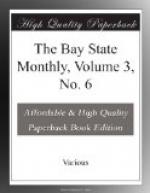This work also possesses strong claims upon our attention. It was completed only a few days before the death of its eminent author. Furthermore, Mr. Arnold knew President Lincoln better than almost any other man; they had been intimate friends for more than a quarter of a century, thinking, conversing and working together during all that time. When the civil war broke out, Mr. Arnold entered Congress; became one of the most trusted advisers of the President; and no one better than he knew and comprehended the latter’s thoughts and intentions; even the cabinet officers and the private secretaries never approached so near to the heart and mind of President Lincoln as did his life long, trusted and admired friend. In 1867, Mr. Arnold published a “History of Abraham Lincoln and the Overthrow of Slavery” which is a work of rare interest and of exceptional historic value. But this work, in the judgment of the author, was unsatisfactory from the fact that, while it depicted well enough the times, it failed to portray the life of President Lincoln. The later volume meets the deficiency, and in fact leaves absolutely nothing to be desired. The spirit of tenderness broods over its charmful pages. Singularly unpretentious, its very simplicity is eloquent and inspiring, and makes the heart of the reader blend with the grand and noble heart of its subject. Its accuracy is unmarred; it explains all doubts that have ever existed in regard to Mr. Lincoln’s motives and acts; it asserts nothing without proving it; it tells the plain, straightforward story, and leaves criticism to others. As a personal biography of Mr. Lincoln’s life and character, this book is not only unsurpassed, but it deserves to rank as one of the classics in our native literature.
THE POLITICAL CONSPIRACIES PRECEDING THE
REBELLION; or the True
Story of Sumter and Pickens, By Thomas
M. Anderson, Lieut. Col. U.S.A. 1
vol. quarto, pp. 100. New York:
G.P. Putnam’s Sons, 1883.
The author assumes that there were “a number of conspiracies” antedating the immediate outbreak of the civil war, but makes no claim that the war was the result of such conspiracies. His narrative, then, is merely descriptive of the events which took place in the period between October 1860 and April 1861, purely resume in character and wholly based upon the disclosures of the Official Records. The author allows himself to criticise men and acts rather freely, and at times captiously; and has evidently intended his book to be a defence of his brother, the hero of Sumter, against certain charges which were once made against him. The old hero needs no defender, even if we suppose that he ever merited criticism. The volume is a small one,—trustworthy as regards its statements and valuable for reference. It may profitably be read in conjunction with the second volume of Mr. Curtis’s Life of James Buchanan, also with the small volume, by General Doubleday, entitled The Reminiscences of Forts Sumter and Pickens in 1860-61.




